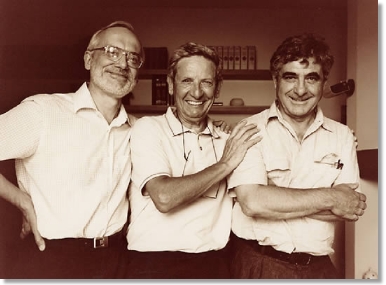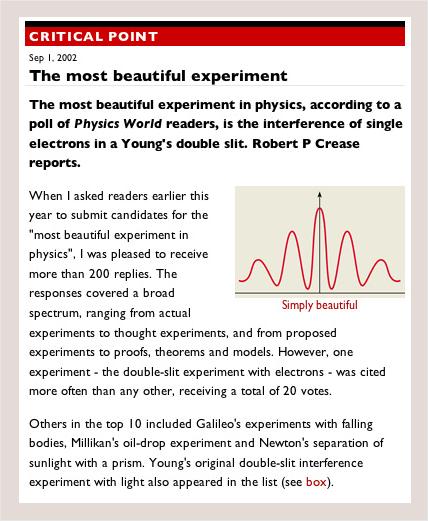 |
It was May 2002 when epistemologist Robert P. Crease launched from the pages of the journal Physics World a poll for the selection of the most beautiful experiments in physics. The one which obtained most quotations was the single electron interference experiment.
The experiment achieves the visual proof of the so called wave-corpuscle dualism, according to which the electron may behave as a material particle, such as a microscopic tennis ball, or as a wave.
Such behaviour, which differs from what we normally observe in everyday life, characterizes very small objects such as electrons, protons and neutrons. As we shall see, light also behaves in a fashion similar to that of electrons.
The through exploration of the microscopic world, a world reaching far beyond the naked eye observation capabilities, which was made possible by the dramatic improvements of scientific instruments occurring in the late 1800s, allowed to focus on phenomena impossible to be explained by means of the existing theories, and often in conflict with the common perception of reality.
In order to explain such phenomena, physicists had to elaborate drastically novel theories, opening quite a new chapter of physics: Quantum Mechanics.
The experiment showing the single electron interference plays a key role in modern physics. So much so that it is usually dealt with in the first chapters of many textbooks of Quantum Mechanics. Surely it is one of the experiments which brought about a revolution in the vision of reality permeating the history of physics and of science in general.
The subject made its entrance in the scientific milieu around 1925, but originally being considered only a thought experiment. Indeed, for a long time it was considered of impossible realization in practice, due to unsurmountable technical difficulties. Yet, a few scientists were engaged in the attempt to overcome such difficulties. A decisive contribution came from three physicists, and electron microscopy experts, from Italy: Giulio Pozzi and Gian Franco Missiroli (Dept. of Physics, University of Bologna), and Pier Giorgio Merli (the onetime CNR-LAMEL Institute, presently CNR-IMM, Bologna). This team was the first to publish in 1976 an account of their successful effort in the American Journal of Physics. The story was also told in an educational movie “Interference of electrons” filmed by the Scientific Film Dept. of the CNR in the same year.
The present web site intends to investigate various aspects of the experiment: its educational presentation, its history, the motivations behind the preference assigning to it the “most beautiful” label, the technical details which led to its successful outcome, the revolutionary consequences it has induced in the perception of reality. Further, a whole chapter is devoted to the 1976 movie “Interference of electrons”, having an educational-popularization character.
A practical reason makes this, far from new, subject, extremely interesting for the present time, since the most recent developments of technology, such as nanotechnology, are based on the handling of single atoms, electrons, molecules, and on the endeavour to use such objects for advanced practical applications (see for instance the quantum computer project). Indeed, as we saw above, the behaviour of such microscopic objects follows the rules of Quantum Mechanics. So the matter becomes important not only for the advancement of scientific knowledge; in the future it is going to play a more relevant role in the developement of technological devices as well.
|
 |


